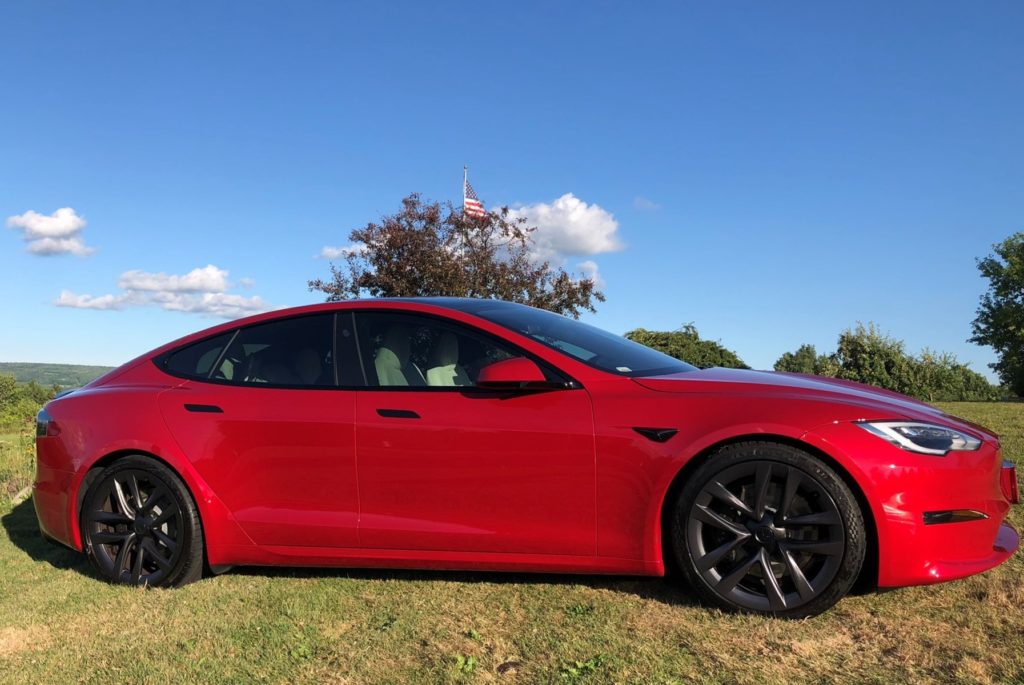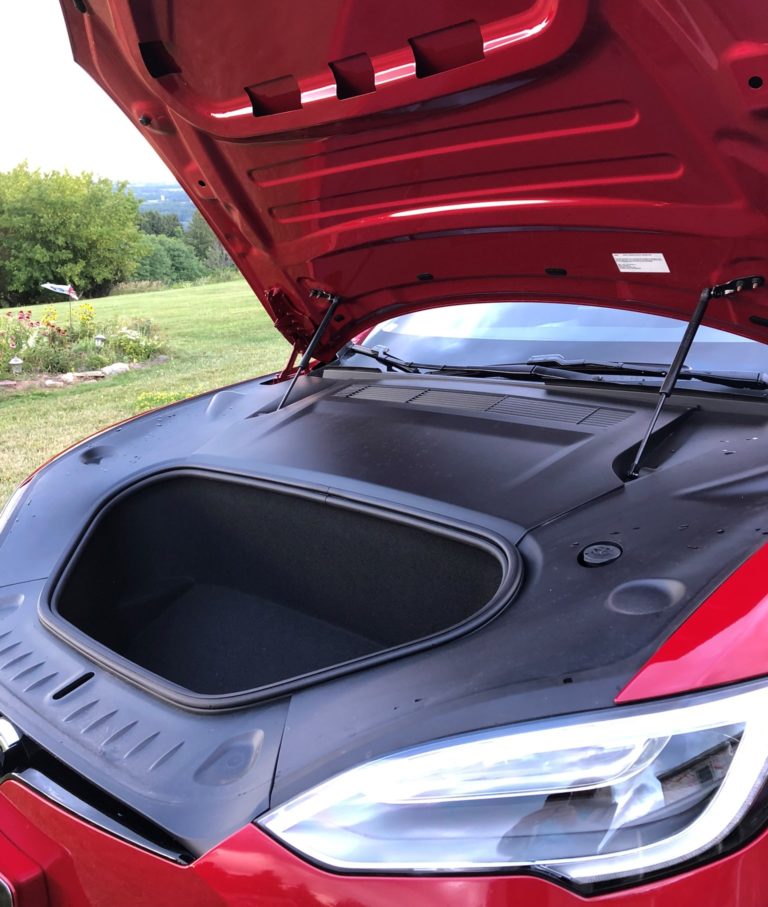Words & photos by Bob Sblendorio
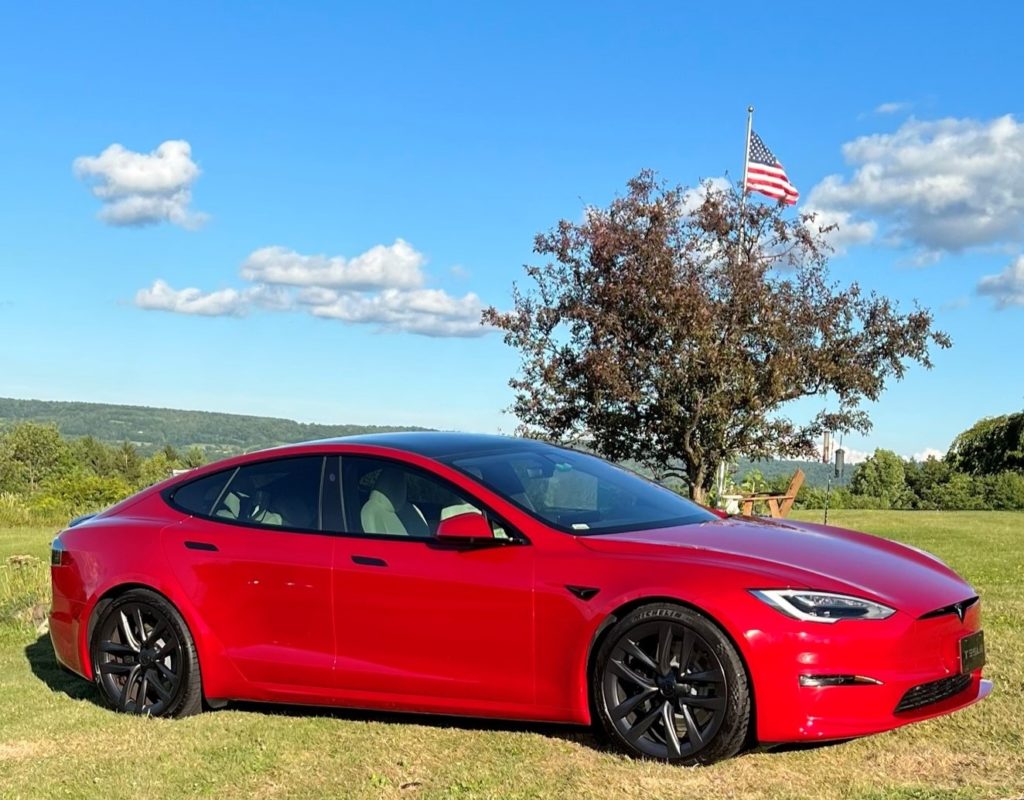
When owner Dave Griffin demonstrated the acceleration of his 1,020 hp 2022 Tesla Model S Plaid he first pre-set my wife and I with the following instructions: “Hold on tight, put your head firmly against the headrest. Are you ready? …here we go.” And go we did! The acceleration is so intense, it’s actually jolting! The acceleration is so fast, it actually seems instant and you’re going 60+ mph, with a force that slams your body into the seat. It’s completely different from what most of us have traditionally experienced of being gradually pressured into the seat as you accelerate. Dave demonstrated several times, and with each came a warning it was coming—boy it was fun. Frankly, it’s hard to reconcile the fact that this is a four-door sedan with seating for five that’s capable of that level of performance.

The published specs from the Tesla website are daunting, like the 0-60 mph in 1.99 seconds (with rollout subtracted), a 9.23 sec. quarter-mile time with a speed of 155 mph and a top-speed of—200 mph! For a street-legal sedan?
The tri-motor arrangement generates 1,020 hp, with 1,050 lb-ft of torque. When trying to put that torque spec into some kind of context, I checked a Ford Super Duty F250, with the biggest diesel engine available, and it too generates 1,050 lb-ft of torque. That’s a sedan with the same torque spec as the powerful F250 Super Duty. Impressive! And just how efficient does it slip through the air? It’s billed as “the lowest on the planet” at a mere 0.208 drag coefficient (Cd). Again, for reference, a C7 Corvette has a drag coefficient of 0.29, which is 39% higher than the Tesla.
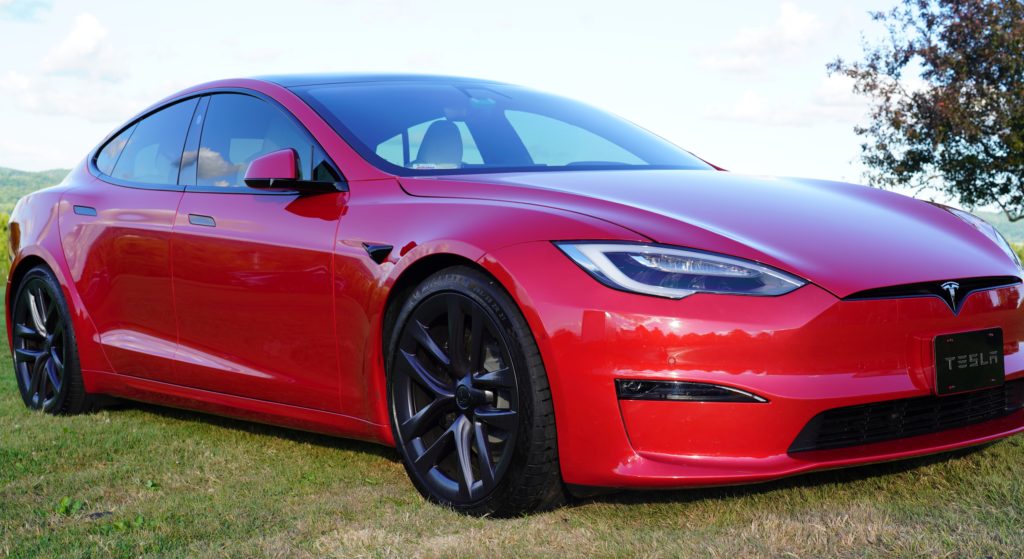
Autopilot (AP)
It was a surreal experience to ride along a country road, while the driver, Dave, is barely touching the wheel (yoke), accelerator or brake pedals. Tesla’s Autopilot system works so well it does all the steering, accelerating and braking, including stopping for traffic lights. As we approached a red traffic light the car stopped as expected. Planning to make a left turn, the directional was blinking and we waited for the oncoming cars to pass, afterwhich the car automatically started turning left once all was clear…all happening with no operator intervention. Generally, it seemed that the greatest challenge while driving in autopilot is to trust the system and trying not to out-think it; just let the system function as designed, but also being at-the-ready to intervene if needed.
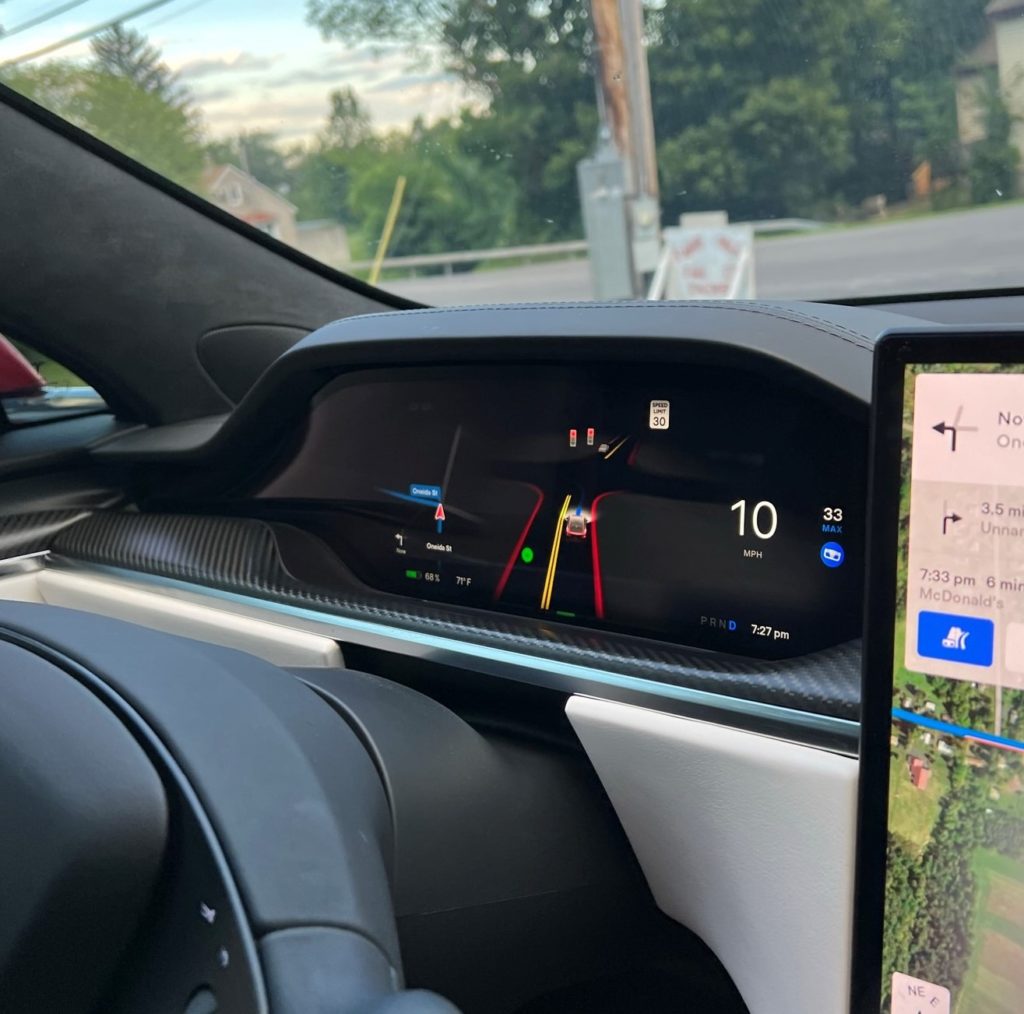
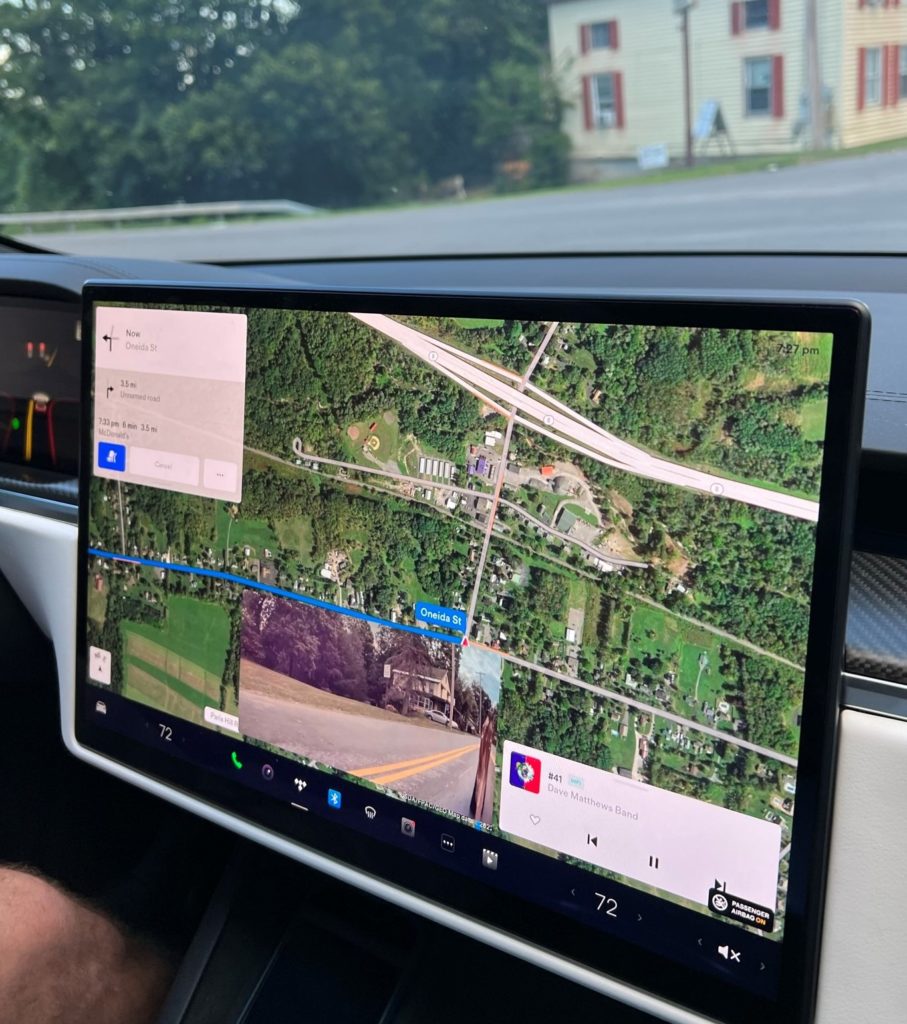
On one occasion, while in autopilot, there was an abrupt alarm sound, with the screen flashing red in an attention getting way. “What’s that?” I asked. Dave explained while he was talking to me (passenger seat) a moment prior, the mirror facing camera detected his head turned instead of forward facing, which is a “no-no” and sounded a warning. The machine knows best…I guess.
The Autopilot feature was initially rolled-out in 2014 with non-stop enhancements ever since. Dave explained that even though other companies also have supervised-autonomous driving, Tesla’s version is one of the most advanced. And as far as highway driving, it’s pretty much “flawless” at this point, in terms of lane changing, braking, exiting ramps, etc. The system operates with inputs from eight cameras. The sonar sensors are used for in-close detection, like the proximity of curbs and objects. For supervised-autonomous driving though, it’s the inputs to the camera system, with the computer interpreting all the data that controls the system, making everything work. The system is so advanced that it mimics the human brain, in terms of pattern matching recognition, using what computer scientists refer to as a ‘deep neural network’…and at this point it seems that it may be at the precipice of exceeding “us” to some degree… It’s actually becoming a little eerie—the concept of machine technology starting to exceed the human brain’s ability at processing. Where is this going?
Dave continued and explained how Tesla can scan the entire fleet of cars (or a segment) for data-gathering for recognition purposes. As an example, if the imagery of a deer running across a road is needed for programming purposes, the fleet can be scanned to acquire data of all car encounters involving a deer crossing a road. Then that data is used to enhance the computer algorithms for recognition of a similar situation. It was starting to feel like the imagery of the cameras, coupled with machine technology of Autopilot might be even better than the abilities of even the most careful drivers out there.
One other example of just how advanced the system operates has to do with safety. While in Autopilot, if the system detects a lack of driver inputs, like occasionally touching the wheel, it will eventually conclude that the operator may have fallen asleep. At that point the Autopilot system will automatically, and slowly, pull the car over to the side of the road, activate the flashers, mute any music that may be playing and sound an audible warning. When the driver wakes up and begins to proceed, it’s time for the “Tesla penalty”—which is not being able to engage the system for the rest of the trip.
In summary, the Autopilot system is very complex, with many other features as well. The above examples are intended to provide a sense of just how far the technology has advanced and where it may be going. As new features are developed they are transferred via over-the-air software updates, making them available instantly.
Battery
The Tesla battery pack continues to change and improve. It’s still a lithium-ion battery pack, but the number of cells and configuration is constantly evolving, as is the battery chemistry. For the Plaid, there are 7,920 cylindrical cells installed into five modules. The battery packs are equipped with cooling and heating systems that improve efficiency and longevity. That’s why even for multiple hard accelerations, the car exhibits very little performance degradation. The cooling system is adequately designed to keep the battery from heating up, even under those kinds of conditions.
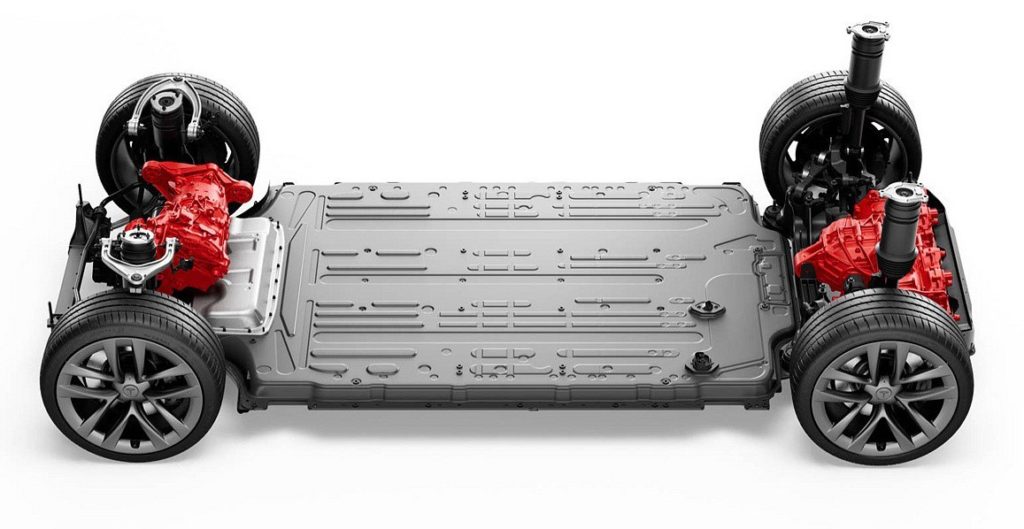
As with previous generations, the most efficient use of the battery is to charge to 80% on longer trips. That seems to be the sweet spot in terms of minimizing charging time versus maximizing range. The latest Tesla 250kW V3 Supercharger stations reduce the charging time down to only about 20 minutes for most sessions, according to Dave. At home, nightly charging time is typically in the 1-2 hour range using a standard 240 volt outlet or the Tesla Wall Connector, keeping in mind that, with nearly 400 miles of range and an average daily drive distance of 40 miles, you’re using and recharging only 10% of your total charge capacity on a daily basis.
While Tesla has always designed and manufactured its own battery packs, they have recently begun manufacturing their own battery cells as well, and at this point is leading the EV industry with the most advanced battery, meaning the highest energy density currently available. More specifically, “core efficiency” is a measure based on the battery kWh, vehicle range and weight. Considering all the EVs on the market, Tesla is approximately 24% more efficient than the nearest competitor in terms of core efficiency, which makes it one of the most-efficient battery packs out there. It may never exceed the energy density of fossil fuels, but it’s getting better all the time.
Interior
The first two features that immediately grab your attention upon entering are the steering wheel, referred to as the “yoke”, and the giant 17” touchscreen. According to Dave the yoke does take a little getting used to, but once your muscle memory is re-trained, it becomes second nature. It’s standard on all new Model S, so if you really want a Plaid, it’s something you’ll have to get used to. The big advantage is the unobstructed view of the dashboard, which is beneficial when using the autopilot system, as the dash is packed with information; such as imagery of all the objects ahead, on each side, and the lane simulations, etc. And as far as for driving on windy roads, on the highway or on a track situation the yoke is advantageous. At slower speeds with a lot of steering invloved, like a parking lot, it’ll definitely take some getting used to.
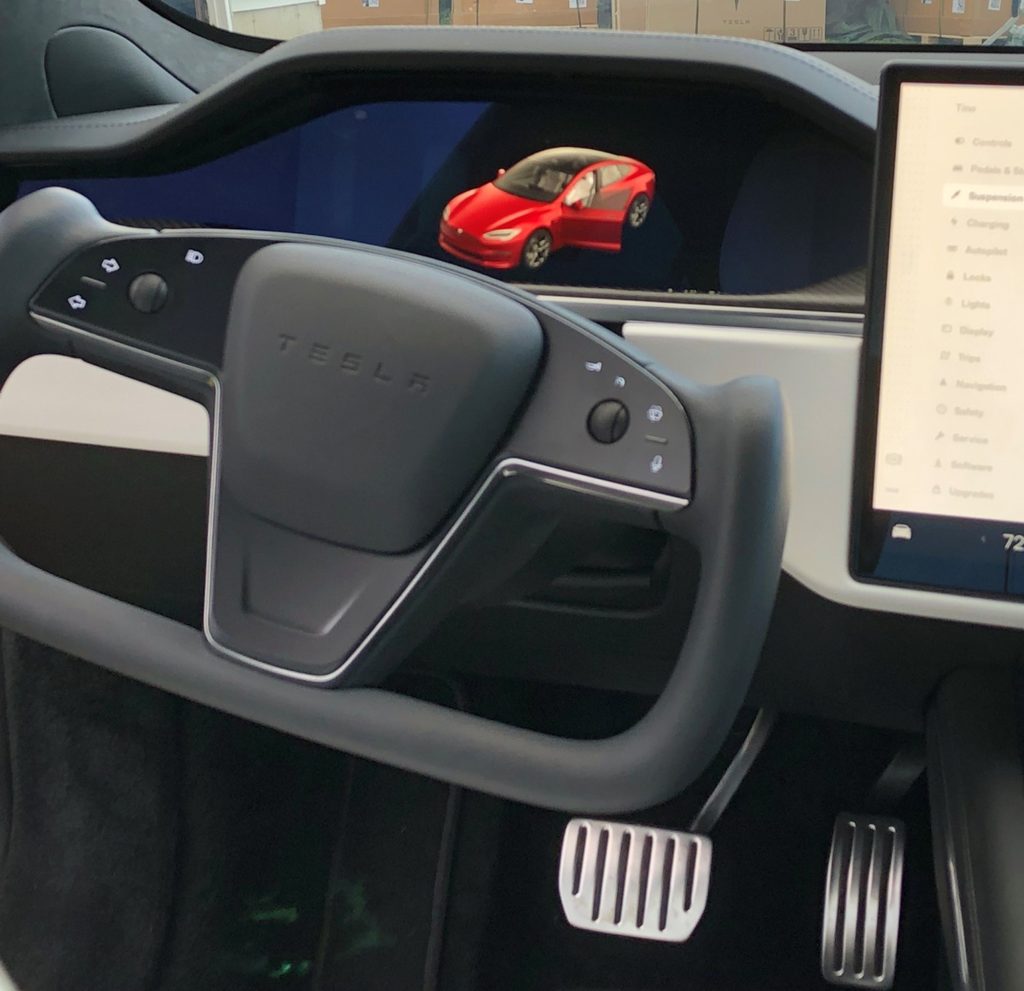
Since Tesla prides itself on a minimalist interior design, nearly everything is controlled or operated from the touchscreen, meaning there are almost no traditional knobs or switches anywhere with just a few exceptions The yoke has some of the traditional controls like directional buttons, volume, voice commands, horn, and a couple others. But certainly the overall design is clean and futuristic. Even the cabin vents are completely hidden.
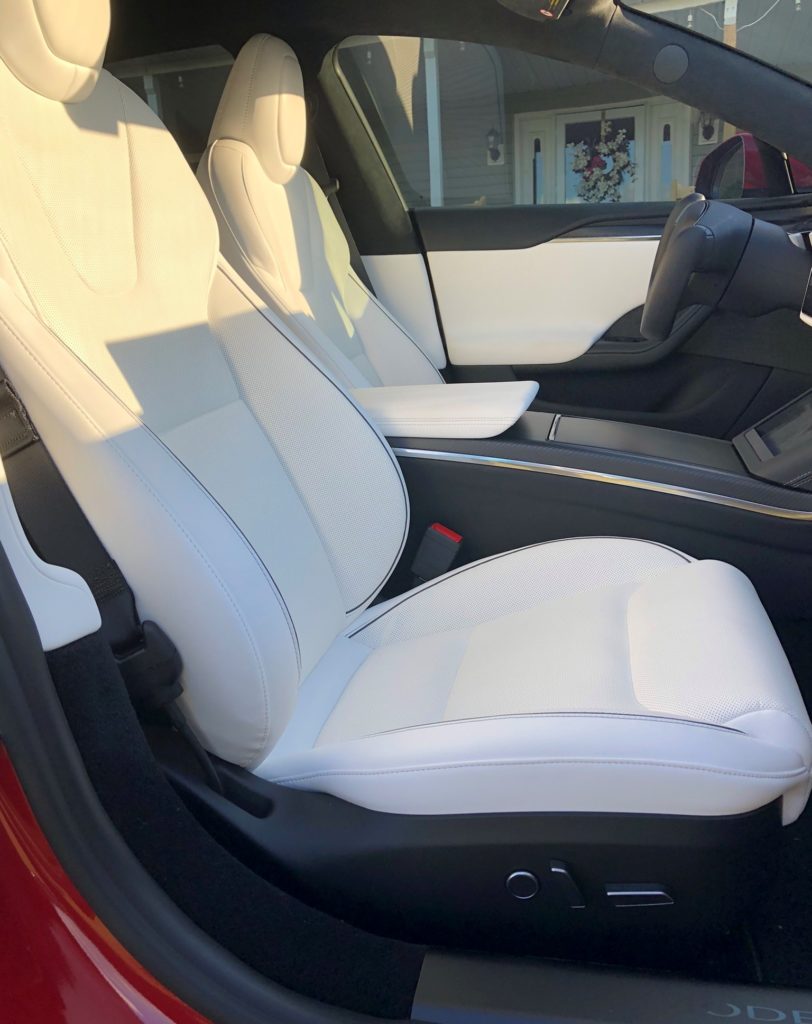
Imagine that your Tesla is parked outside your garage and you want to go for a ride. As you walk up, with the fob (or just your smartphone) in your pocket, the car automatically unlocks when you get close, the door handle pops out and you open the door to get in. After buckling up, you put your foot on the brake pedal and the car intuitively knows you want to go in reverse (there’s no gear shifter), so you’re ready to back up. That’s it. If instead you want to go forward a couple of feet, that can be changed by swiping up on the touchscreen instead. Those are just a few samples of the many unbelievable features that Dave talked about.
Final thought
A few years back a friend made the following comment: “The technological advances in the next 5-years will likely exceed all the advancements of the past 50-years in the automotive industry.” At the time it seemed like a far-fetched concept…but I stand corrected. After hanging-out with Dave, an electrical engineer by trade and an expert all-things-Tesla, my friend was bang-on in his prediction. A luxurious self-driving four door sedan with 1,020 hp, capable of 0-60 mph in less than two seconds and a top-speed of 200 mph…is impressive by every measure!
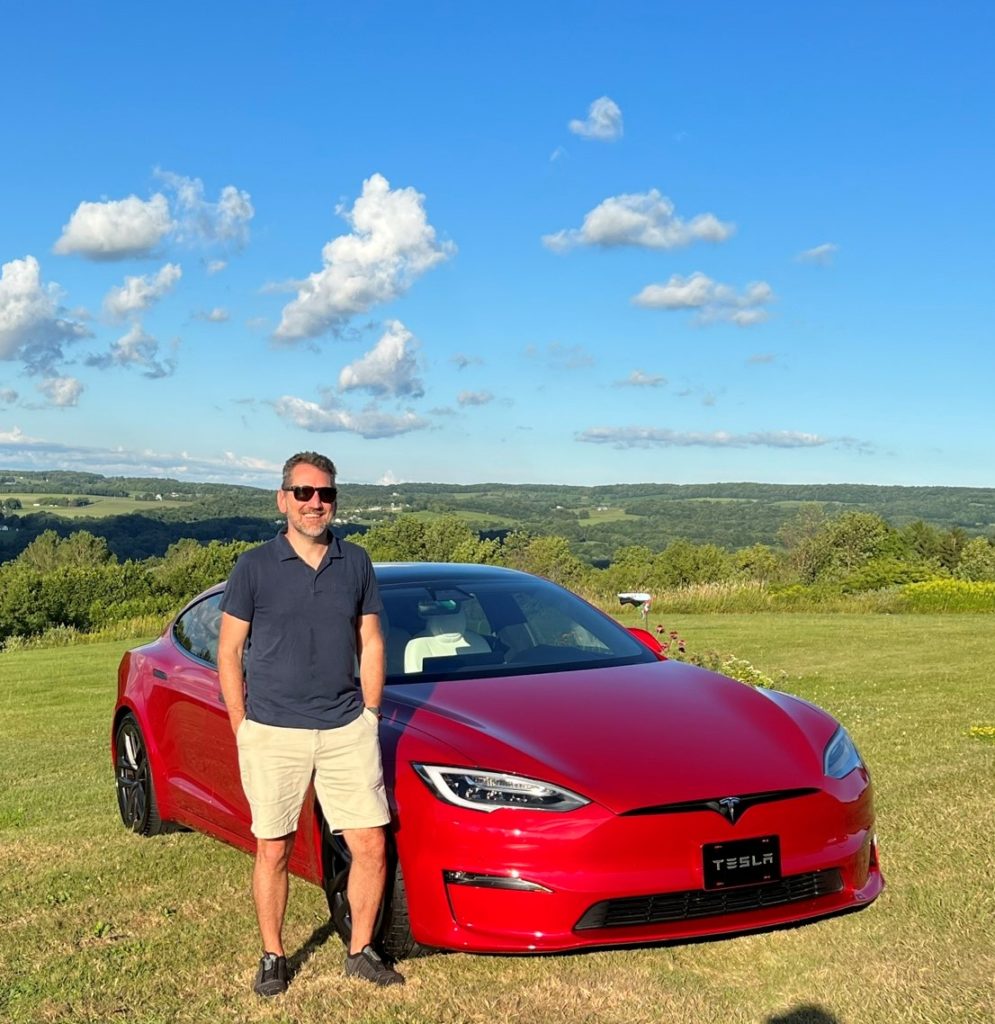
Dave’s 2022 Tesla Model S Plaid
Car body | Liftback Sedan |
Range | 348 miles (396 miles w/smaller 19” wheels) |
Horsepower | 1,020 hp |
Torque | 1,050 lb-ft |
0-60 mph | 1.99 sec with rollout subtracted 2.1 sec with no rollout |
¼ Mile | 9.23 @ 155 mph |
Top speed | 200 mph (with paid upgrades) |
Powertrain | Tri-motor, awd (2-rear, 1-front) |
Battery, 100 kWh | 7,920 lithium-ion cells, Nominal voltage 400 v |
Max Supercharging | 250 kW |
Charge time, Supercharging Station | 187 miles of range in 15 minutes, or 30 minutes for 80% charge |
Charge time, at home, 240-volt | Approximately 11 hours for a full charge, though typical nightly charge time is 1-2 hrs in most cases |
Drag coefficient | 0.208 (one of lowest for a production car) |
Braking | Friction and regenerative |
Weight | 4,766 lbs |
Warranty, basic | 4-yrs or 50,000 miles |
Warranty, battery & drive | 8-yrs or 150,000 miles |
Delivery for Dave | December 31, 2021 |
Cost for Dave | $133,690 (there have been several price increases since) |
